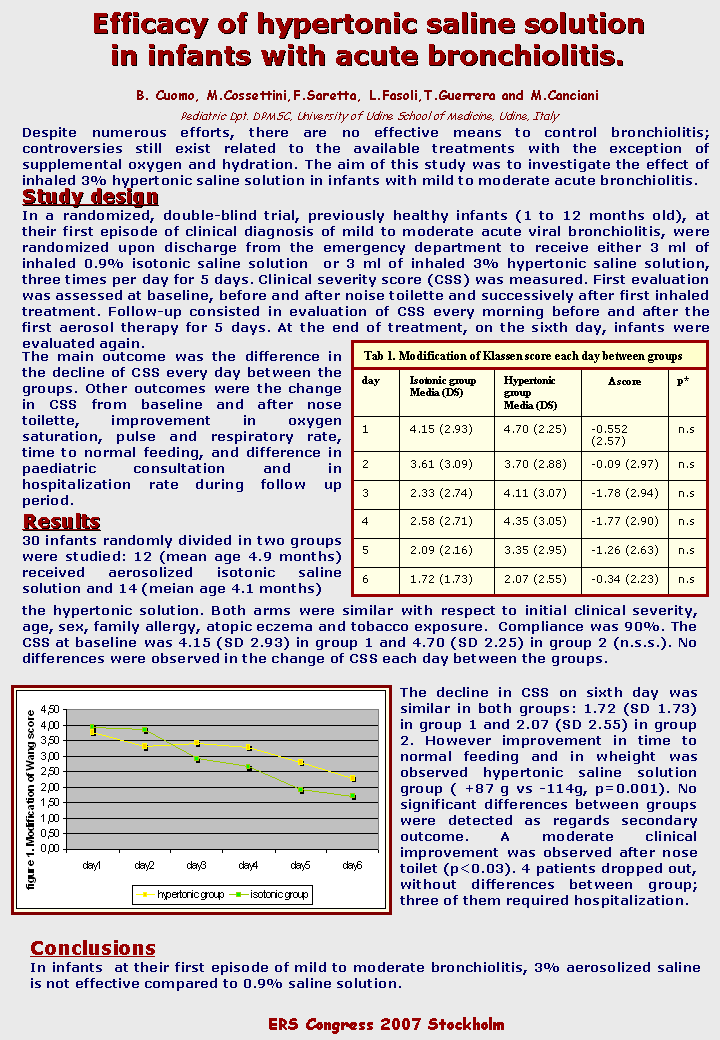Nasal Nitric Oxide and nasal smear in atopic children
Saretta F., MD1; Cossettini M., MD1, Benfatto I., MD1, Morittu A.1, Artico D. ,MD2 and Canciani M., MD1.
1 Pediatric Department DPMSC, University of Udine; 2 Pathology Department, University of Udine.
Background: The exact origin of nasal nitric oxide (nNO) it is still unknown. Most studies indicate it within the epithelium of paranasal sinuses and the increased activity of nitric oxide synthase seems to be due to persistent mucosal inflammation.
Aims: We tried to verify if there was a correlation between nNO values, cellularity of nasal smears and type of allergic disease (asthma, seasonal and perennial rhinitis) in a pediatric population.
Methods: 31 children (22 males and 9 females) with a mean age of 10.6± 1.7 years during a camp holiday in August 2006 were studied. All children were allergic: 10 asthmatic, 9 asthmatic with seasonal rhinitis, 9 asthmatic with perennial rhinitis, 1 asthmatic with conjunctivitis, and 2 with perennial rhinitis. We performed nasal smears (one for each nostril) and nNO (one detection for each nostril) with CLD77AMÒ (EcoPhysics), in the same occasion.
Results: All children had high value of nNO (mean value of 1468 ± 290 ppb). Evaluating the patients according to diagnosis, we found a significantly higher nNO in the perennial rhinitis group with or without asthma (nNO value 1609 ± 225 ppb), compared to asthmatic with and without seasonal rhinitis (nNO value 1390 ± 297 ppb), p=0.04. Any correlation between nNO and percentage of eosinophils or neutrophils in nasal smears was found.
|
All children (mean value) |
1468 ± 290 ppb |
|
|
Perennial rhinitis (with or without asthma) |
1609 ± 225 ppb |
<p=0.04> |
|
Seasonal rhinitis (with or without asthma) |
1390 ± 297 ppb |
Conclusions: Patients with perennial nasal inflammation had significantly higher nNO values, independently from the asthmatic history, reflecting mostly nasal inflammation. Our inability to find a strong correlation between nasal cellularity and nNO values demonstrates that paranasal sinuses are probably the main source of this inflammation mediator.
Utility of flow cytometry in diagnosis of amoxicillin allergy in children
Saretta F. MD1, Ganis RZ.1 MD, Canciani
M. MD1, Toffoletto B. PhD2, Cesselli D. MD, PhD2
.
1 Pediatric Department DPMSC, Udine University, Italy; 2 Pathology Department, Udine University, Italy.
Background: Flow cytometry is a diagnostic instrument that has been demonstrated to be useful in the diagnosis of allergic reactions, too. Almost all published studies are based on adult.
Aims: The aim of this study was to investigate a pediatric population and to assess whether previous results could be applied to children in evaluation of drug allergy.
Methods: 9 pediatric patients (mean age: 6.4 years) with immediate reactions to amoxicillin (AMX) were studied. One child had a recent reaction (one week previous to testing); other patients had a reaction in a time range between 5 and 136 months before testing. We performed prick and patch tests (prepared before testing, using both the liquid and the solid form of the drug, and both in pure form and diluted in 30% vaseline and in 30% saline), IgE dosage and basophil activation test (BAT). This latter identified basophils as CD123+HLA-DR- leukocytes and used CD63 marker to assess the activated fraction.
Results: Two children had a positive prick test (mean wheal 3 mm) and positive BAT suggesting an IgE-mediated allergy. One child, with negative prick test, had a positive BAT, suggesting a non IgE-mediated reaction to amoxicillin. All patch tests and all IgE dosages were negative. Two children, negative to the antigen test, showed a very high reactivity when basophils were challenged with anti-IgE antibodies (positive control), suggesting a hyper-reactive state; these children had a weak positive prick test (mean wheal 1 mm) and one had a history of reactions to drugs and food, and the other to wasp venom.
Conclusions: Even though we studied a small group of patients, this preliminary observational study shows that BAT is feasible in the pediatric population in the evaluation of drug reactions.
UTILITY OF RESPIRATORY RESISTENCES IN ORAL FOOD CHALLENGE IN A CHILD
Saretta F. MD1, Cuomo B. MD1, Cossettini M., MD1 and Canciani M. MD1.
1 Pediatric Department DPMSC, University of Udine, Italy.
Background: Single occlusion technique is a simple, non invasive method for measuring passive respiratory mechanism and respiratory resistances. Usually it has been used to investigate respiratory mechanism related to respiratory disease such as asthma or wheezing illness.
Aim: We tried to evaluate the utility of monitoring respiratory resistances during an oral food challenge in patients with suspected immediate reactions to egg.
Methods: We measured respiratory resistance with “single occlusion technique” (Vmax 26, Exhalyzer®, SENSOR MEDICS) before and after a double blind placebo controlled food challenge (DBPCFC) with egg. The child, 3 years old, had positive skin prick test for egg (mean wheal for yolk and white 3 mm) and a suspected history of cough and wheezing after eating egg.
Results: Respiratory resistances before and after food challenge, both in the first and in second phase of the challenge, are reported (see table). We found a variation after the challenge and after administration of a bronchodilatator, too, in the first phase of challenge, when children had a reaction (vomit and abdominal pain). So we suggested to continue restricted diet, but the mother decided to administred egg.
Conclusions: Evaluation of respiratory resistance could be an interesting method of monitoring respiratory reaction during oral food challenge, to exclude immediate and dangerous reactions.
|
|
Pre-challenge |
Post-challenge |
After bronchodilatator |
|
First phase (egg) |
Mean 30.15 kPa/(L/sec) ds 4.27 CV 14% |
Mean 38.13 kPa/(L/sec) ds 4.27 CV 16% |
Mean 23.69 kPa/(L/sec) ds 3.08 CV 13% |
|
Second phase (placebo) |
Mean 7.94 kPa/(L/sec) ds 7.17 CV 90% |
Mean 1.54 kPa/(L/sec) ds 0.41 CV 26% |
Mean 9.05 kPa/(L/sec) ds 2.10 CV 23% |
